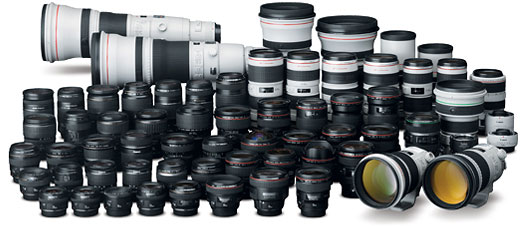Canon L Series lenses – Ahhh that off white barrel and red circle that screams “professional” and of course “expensive”. Is the extra expense of Canon’s L Series lenses worth the extra $500+ dollars to the average photographer?
Certainly the professional who can write off camera equipment expenses can afford the very best lenses on the market but does the average photographer need the extra dust and water-resistant rubber seals? Perhaps not.
What makes Canon L Series Lenses Special?
Canon’s series of L lenses (Canon Luxury Lenses) are a professional line of SLR photography lenses made by Canon. Canon has sold zoom and prime L-series lenses for the discontinued FD lens mount and for the current EF lens mount used on all Canon EOS cameras.
Most L series lenses share a number of common characteristics not found in Canon’s line of lower-end lenses. L lenses tend to be more durable, incorporating dust and water-resistant rubber seals on some models. L lenses also contain optics of higher quality, with many lenses containing aspherically ground, fluorite or ultra-low dispersion glass elements. Their front elements do not rotate for the proper operation of some filters, such as circular polarizers. L lenses are often “fast”, with maximum apertures commonly f/2.8 or f/4 and never exceeding f/5.6. Standard prime lenses have a much higher maximum aperture, with both of Canon’s current 50mm and 85mm L lenses which open to f/1.2. All current L-series lenses have ultrasonic autofocus motors (USM) and extra communication pins, except for the specialist tilt-shift lenses which do not provide autofocus.
Price Comparison between standard series lens and Canon L Series Lens – 50mm
Canon offers several 50mm lens which range in price from just over $100 to over $1,200 for the Canon L Series version of the 50mm lens.
What do you get for your extra $1,000 or so? Larger glass, the L series goes to a full open aperture of f/1.2 for very shallow depth of field and superiour boken. Bigger glass costs more to manufacture. Also you get the superiour weather sealing, lens coating and better construction.
The Canon EF 50mm f/1.2L USM lens is a peerless standard lens for Canon digital SLR cameras. The lens is suitable for any shooting situation, with a lens coating and construction type that are optimized to minimize the ghosting and flare that frequently occurs when lenses are used with digital cameras. The lens also offers an ultra-large aperture that produces a narrow depth of field and the type of soft background blur so loved by photographers everywhere. The high-performance, weather-resistant lens delivers all the superb image resolution and contrast you expect in a Canon L Series lens.
The Least Expensive Canon L Series Lenses
The least expensive way to explore the world of Canon L series lens is with the wide angle zoom, the 17-40 mm L. Professionals swear by the 16-35 L zoom (either in the f/4 version or the more expensive f/2.8 version) but the 17-40 mm L can be found for under $800.
Here are a few photographs I’ve taken using the Canon L Series 17-40mm lens:
Another option for tip toeing into the Canon L Series lenses without breaking the bank is the 24-105mm zoom which often comes as the kit lens for camera’s such as the Canon 6D. You can get new one for around $1,000 or a used one for $700 or so.
Touted by some as a great walk around focal length, I got mine with my Canon 6D but never liked it. I don’t know if I got a bad copy or just didn’t like the focal range. Color reproduction was good but the sharpness always seemed off at the long end of the range. After using primes like the 35mm, 50mm and 85mm, I’m just used to very sharp images.
Another option is the celebrated 70-200mm L series lenses. There are the legendary lenses that professional wedding and portrait photographers buy into the Canon system to obtain. There are plenty of working photographers who use nothing but these zoom lenses as the core of their business.
Why are they so celebrated? For the ability to blow out the backgrounds and obtain beautiful boken, especially with the f/2.8 version.
